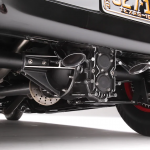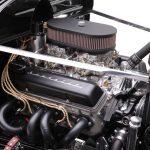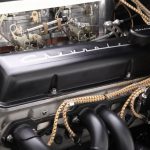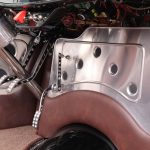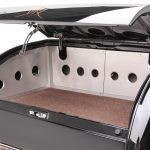1929 Ford Roadster Packs a Big Punch
Hot Rod Magazine, Eric GeisertwriterApr 9, 2015
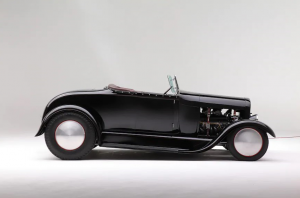 When Darrell Cimbanin and his brother, Tim, started CimTex Rods in Jarrell, Texas, almost 15 years ago, they were both car enthusiasts who liked to go fast. Both had street racers and, together, they successfully campaigned an F-stock drag racer. Over the years CimTex has produced some spectacular cars for their customers, including several class wins at ISCA events, cars debuted at the annual SEMA Show in Vegas, and a couple handfuls of high-end awards, such as Goodguys’ Truck of the Year. Darrell, who started out building model cars as a boy, moved on to real cars by the age of 12, and has always been intrigued with what makes them tick. And, though the shop he co-owns with his brother works on all sorts of vehicles (from Corvettes to 1950 Fords), Darrell had always harbored a special place for a Model A roadster.
When Darrell Cimbanin and his brother, Tim, started CimTex Rods in Jarrell, Texas, almost 15 years ago, they were both car enthusiasts who liked to go fast. Both had street racers and, together, they successfully campaigned an F-stock drag racer. Over the years CimTex has produced some spectacular cars for their customers, including several class wins at ISCA events, cars debuted at the annual SEMA Show in Vegas, and a couple handfuls of high-end awards, such as Goodguys’ Truck of the Year. Darrell, who started out building model cars as a boy, moved on to real cars by the age of 12, and has always been intrigued with what makes them tick. And, though the shop he co-owns with his brother works on all sorts of vehicles (from Corvettes to 1950 Fords), Darrell had always harbored a special place for a Model A roadster.
So when Kenny Kurtz, a longtime friend from Ohio, told Darrell about an A roadster he’d just bought, Darrell was interested. Kenny, being a 1932-only kind of guy, sold the project to Darrell, which was a rolling chassis and body, with no engine or transmission. Not wanting to cut into any of their customer’s project time, Darrell worked on the roadster sporadically over the next six years, but it was recently finished and ready for the road.
The concept for the roadster was, of course, to look good, but also have enough performance to get someone’s attention. To that end many of the car’s parts are performance oriented. Darrell began by reworking the Brookville Roadsters frame by adding a custom crossmember, a 7-inch kick to the rear, and custom engine/trans mounts. The rear suspension revolves around a Winters Champ quick-change, outfitted with 3.09:1 gears, Strange Engineering axles, and a parallel four-link system that works with Aldan coilover shocks and a CimTex-fab’d Panhard bar. The front would see a drilled ‘n’ dropped (4-inch) I-beam axle equipped with a Posies spring and another four-link system.
By looking at the engine specs for Darrell’s ride, you can tell this car wasn’t built to be a grocery getter—it definitely has the right stuff to remind you this is a hot rod, not a street rod. Starting with a four-bolt-main 350 block bored 0.030 over, CimTex assembled the 355 using a SCAT crank and rods, Keith Black pistons (set up with an 11:1 compression ratio), and a COMP Cams camshaft. GM Performance heads, equipped with a COMP Cams springs and Crower roller rockers, is fed by twin Edelbrock 550 carbs on an Edelbrock manifold.
CimTex built the air cleaner, and a Walker radiator, polished short-nose GM water pump, and a 14-inch belt-drive fan system from Fatman Fabrications keeps everything running cool. A Vertex magneto (with old-school Bauer Electronics cloth-wrapped wires) delivers the spark while shop-built headers and a 3-inch stainless exhaust system exiting out 3-inch Stainless Works turbo mufflers comprise the exhaust system. A Richmond five-speed transmission was then bolted up with a McLeod Racing clutch, disc, and Hayes aluminum flywheel, with the aluminum driveshaft (with an emergency brake disc added) cut down at CimTex. Fuel comes from a 20-gallon gas tank from Tanks.
A handful of mods were done to the body of the roadster, but they’re subtle. You might miss the shaved door and trunk handles or the 4-inch bobbed rear fenders, or maybe even the chopped windshield posts or dropped headlight bar that still uses the Model A headlamps. There’s also a minimal amount of chrome used on the car, but what’s there was done at Jon Wright’s Custom Chrome Plating in Grafton, Ohio (with Darrell’s brother, Tim, making the trips to Ohio to get them done). The firewall was recessed, the trunk floor raised, a custom rear roll pan added, and a new hood made to fit the peaked Model A radiator shell (no hood sides were made for the car). To reinforce the structure of the body 1-inch tubing was fab’d before the body was rolled into CimTex’s paint booth, where it received multiple coats of black DeBeer Refinish paint (a division of Valspar). Taillights from a 1939 Ford and pinstriping from Lil’ Louie (San Bernardino, California) finished up the car’s exterior.
Inside the cockpit an aluminum panel (filled with lightening holes) fits under the dash, and another similar piece can be found in the trunk, too. The car’s dash is from a 1932 Ford roadster, and houses five Classic Instruments gauges, wired up with an American Autowire wiring kit. Just to the right of the wooden MOMO three-spoke steering wheel (re-dyed by Darrell to match the car) is a 10,000-rpm Vertex tachometer—easily read from the comfort of the Butler bucket race seats, covered in marine vinyl by Vernon McKean Interiors in Liberty Hill, Texas.
Once the roadster was dialed-in, Darrell was out on those long Texas roads testing the car, and he was impressed. So much so, his comment was that it’s a little bit of a challenge to drive, and “It hates going slow and stoplights.” It comes off the line hard and, when he’s into it, the shift point on the Vertex tach reads 6,000. His plan is to head out to the Bowling Green event, or maybe the Goodguys Indy show where they pick the Hot Rod of the Year. Either way it’s all about the ride when you’ve got a car like this to get you there!



